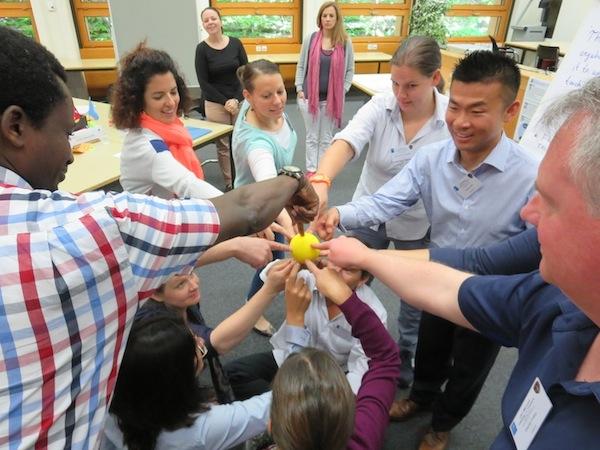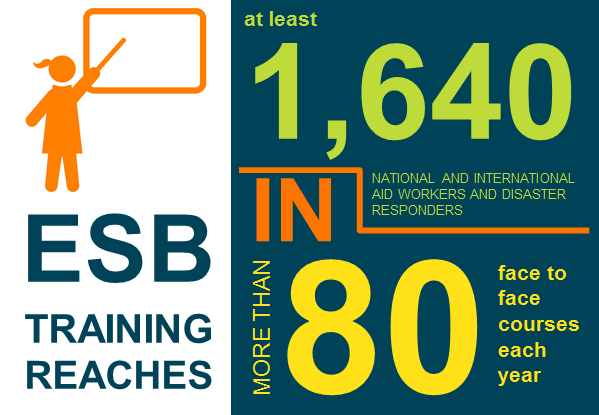Every year, OCHA’s Emergency Services Branch (ESB) trains, and re-trains, more than 1,600 aid workers and disaster responders in more than 80 face-to-face courses. Hundreds more are reached through online training. With many large-scale humanitarian crises straining our capacity to respond, in this issue of Dispatch we ask why we train and what is next for our training.
Training to influence
Training and education can be an important advocacy tool, and can also be a change agent. Following the recent Nepal earthquake, Dr. Ian Norton, head of the World Health Organization’s (WHO) Foreign Medical Teams initiative, highlighted the added value of ESB’s On-Site Operations Coordination Centre (OSOCC) and the United Nations Disaster Assessment and Coordination (UNDAC) trainings. “We had worked with some of the UNDAC teams, so from my side, coming from WHO to work with an UNDAC team that I had met and trained with before (…) worked very effectively. We moved 142 foreign medical teams and the training beforehand was vital,” says Dr. Norton.
ESB’s trainings provide opportunities to build understanding of humanitarian principles as well as complementary role of the many diverse actors involved in responding to emergencies. For example, the UN-CMCoord Training Programme brings civil and military personnel together to learn from each other and build an understanding and appreciation of the different, but complementary roles performed by humanitarian and military actors. Trainings also help to build trust, which in turn can contribute to response effectiveness. This was seen during the response to Typhoon Haiyan in 2013, during which “informal professional networks among relief workers built during common training and exercising facilitated the trust needed for effective and efficient cooperation, particularly early in the response phase” (source).
ESB trainings are targeted at staff, the wider humanitarian community and member states. Equipping staff and partners with humanitarian principles, tools and an understanding of the variety of context where humanitarian response will be required, is a key objective in the training environment.
Training to keep pace
In a rapidly changing environment, with increasing professional and personal demands, it is even more important that those required to deploy for a humanitarian crisis have the skills, knowledge and attitudes needed to effectively support the response. “It’s important that we recognize that it’s not really possible to ask our staff to perform well if we haven’t given them the tools and the confidence to fulfill their function,” says Marion Orchison, Coordinator at the Stand-By Partnership (SBP) Training Secretariat. Recognizing that the complexity and of the humanitarian environment presents a host of response challenges, training – and re-training – to keep pace with developments in the humanitarian architecture and standards is crucial. For example, UNDAC Consolidation Courses aim to update UNDAC members on the latest developments and revised methodology. At the same time, the UNDAC Team Leader course is under revision and will include lessons identified in Nepal.
The nature of our work and the inherent responsibilities in OCHA’s mandate require that we are prepared to deal with uncertainties in emergency response operations. Designing training for these uncertainties is particularly challenging. ESB flagship courses therefore, aim to bridge operational realities, with the emergency “unknowns”; by fostering a mindset which allows participants to anticipate and address uncertainties. For example, the Field Response Surge Training (FIRST) prepares OCHA staff to boost humanitarian coordination and support rapid upscaling of Country Offices. Similarly, ESB provides contribution to Standby Partners trainings seeks to prepare external experts to quickly transition into OCHA to support coordination and information management functions, while preparing them for the realities of working in complex emergencies contexts. Similarly, the OCHA-supported Inter-Agency Gender and Protection Stand-by Capacity Projects (GenCap/ProCap) include training components that seek to expand the protection and gender knowledge and skills to address challenges faced by Humanitarian Country Teams.
Working to improve
Over the past years, ESB’s has been shifting its training methodology from a traditional approach, in which “experts” lecture participants on various subjects, to an experiential learning that emphasises the participant as the central component of the learning experience. This type of facilitated learning environment strives to foster collaborative learning by building knowledge, developing skills and influencing attitudes and behavior. ESB draws on a variety of training methodology and has recognized the importance of contextualizing each course to the specific needs and environment for the target audience.
ESB also recognizes the importance of feeding in lessons from first hand experiences and observations in emergency response operations. After action reviews, end-of-deployment debriefings and discussions across the organization and with other partners all provide valuable insights into adaptations required for updating / revising or developing new training events. Getting the right balance of profiles and experiences in each course is also a priority.
In the almost four years Ms. Orchison, from the SBP Training Secretariat has worked as a partner to OCHA supporting ESB training, she has noted considerable improvement in course design, although she acknowledges there is still room for strengthening synergies and coherence. This is being tackled through an ESB-wide training mapping exercise, which aims to ensure that all courses are based on identified needs, clearly articulated learning outcomes and peer discussions. Linking ESB training with other training initiatives across the organization – under the overall guidance of the Staff Learning and Development Section – has also begun.
Maximizing training resources through e-platforms
Tailoring courses at the appropriate level, frequency and context, alongside monitoring the practical application of the learning objectives require resources. Recognizing that resources will always be limited, ESB is striving to maintain reach and stretch limited training resources through a number of online presentation and e-learning opportunities. For example, the Environmental Emergencies Centre (EEC) is an online tool designed for National authorities and EEC partners, with the aim of strengthening capacity to respond to environmental emergencies. Available in several languages, the EEC hosts five e-learning modules covering preparedness for environmental emergencies; industrial accidents; disaster waste management; environment in humanitarian action; and the Flash Environmental Assessment Tool (FEAT), which is currently under a redesign process.
The UN-CMCoord training strategy also makes use of online tools including by providing partners with the opportunity to discuss topics and “hot” issues through webinars. Trainings are supported by Google+ Community of Practice on UN-CMCoord; and also the Humanitarian//Military Dialogue Website, which serves as a resource centre that includes a Training Highlights Page, posters on CMCoord in official UN languages and a video library. In addition, the US Office for Foreign Disaster Assistance and the United States Institute for Peace is supporting the development of an UN-CMCoord e-Course.
An OSOCC Awareness e-learning course is also in the early stages of development, after a learning needs analysis exercise highlighted the potential benefit of building wider recognition of this important coordination tool.

Training as a strategic investment
ESB believes that those who raise their hands to deploy into high intensity, challenging humanitarian environment deserve to be supported by a coherent and comprehensive training services. To continue to address the needs, challenges and changes in the humanitarian field, OCHA must recognize that training and learning is a strategic activity. Why do we train? Because investment in training yields dividends in providing a quicker, more predictable and coordinated humanitarian response. Nowhere does this become more tangible than in major emergencies.


I am index officier but i retired from under since 30 September 2014. How May I help you?
I am 63 years old and ready to go.
LikeLike
Great overview of what we do so well in support of individual learning and continuous growth of the organization. Congratulations!
LikeLike
Besides developing subject matter expertise, e.g. for humanitarian civil-military coordination we would like to apply OCHA’s policy instructions on the role of humanitarian civil-military coordination, we influence other organizations to work together more seamlessly in the same operating environment. We also expand and sustain our global network, which is the strongest I have ever come across in the last 16 years with the United Nations. And most importantly, we sensitize emergency managers from disaster stricken countries for what might additionally be put on their ‘shoulders’ in times of stress.
LikeLike